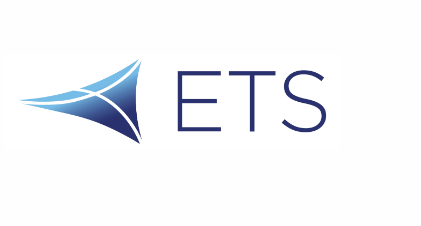This CE Center article is no longer eligible for receiving credits.
Lighting Solutions and Shading Systems
Shading systems can effectively control daylighting in commercial buildings and also serve as integral design elements. They can be installed on the exterior or interior of buildings, and even between glazing units or within a double facade. There are many types and styles of modern shading systems used to control daylighting in modern commercial architecture.

Photos courtesy of Richard Wilson
Interior shading systems include shades that can be raised or lowered fully or left at intermediate positions depending on the time of day.
Exterior vs. Interior Shading Systems
Exterior shading systems have a big advantage over interior systems: they significantly reduce unwanted solar heat gain by eliminating one of the sources of that gain. Solar radiation is absorbed by shading material, whether installed inside or outside a building. The short-wave solar energy that is absorbed by the shading system is converted into long wave energy (i.e., heat). With an exterior system, this heat is radiated outside the building and never reaches the glazing. However, solar energy that is absorbed by an interior shading system and is then radiated as heat is trapped inside the building. An effective exterior shading system can block 90 percent or more of solar gain. This can contribute to lower HVAC demand, which in turn can contribute to a downsized HVAC system, lower capital costs, and lower operational costs over time.
Interior shading systems consist of shades or blinds that can be operated up or down. Interior blinds incorporate slats, the angle of which can be adjusted to control light, glare, and solar heat gain. Interior shades can be raised or lowered fully or to intermediate positions, depending on the time of day and amount of direct sunlight. Although they are not as effective as exterior systems at keeping solar heat gain out of the building, interior shading systems have other advantages. For instance, there are more material (fabric) options since the shades are not in direct contact with the elements (though they are still susceptible to UV damage). Because they are part of the indoor environment, however, it is important to consider how the material choice impacts indoor air quality. Interior shading systems can be motorized or operated manually.
Examples of exterior solutions include brise soleil systems (i.e., fixed louvers that are installed at the head of the glazing) as well as horizontal louvers and vertical louvers that are installed in front of the glazing. Roller shades and venetian blinds can be used in both interior and exterior applications and retracted into a pocket or a head box when not required. Retractable systems allow for responsive shading—shading that is deployed during certain times of day or under certain weather conditions. In addition, the slat angle of exterior venetian blinds can be adjusted according to the sun’s angle, allowing the maximum amount of ambient light into the building while preventing any direct sun penetration.

Images courtesy of Draper, Inc. and Richard Wilson
Exterior shading systems are more effective at keeping solar heat gain out of the building when compared to interior shading systems. Various types of external shade options are available.
Exterior shading systems are effective throughout the year, which means that they will prevent solar energy from entering the building in the winter as well as the summer months. An advantage of retractable systems is that they can be disabled and left in the retracted position during the winter months, when solar heat gain might be desirable. This is dependent on the building’s heating and cooling cycle. In more southern latitudes, a building might require cooling throughout the year. In more northerly climates, however, winter heat gain is beneficial, and retracting the shading systems to make maximum use of these gains therefore makes sense. If this is the case, however, an interior shading system will also be required to manage daylight and address glare.
Though designed for exterior conditions, these systems should be retracted fully during high-wind events; they also need to be protected from ice and snow. Exterior roller shades that incorporate zip technology are very wind resistant and are an ideal solution for exposed locations and taller buildings. Such systems include steel zippers welded onto the vertical edges of the shade that “lock” the shade into the channels and prevent them from being pulled out by the wind.
Shading systems also can be installed within a double facade. While this type of facade construction is not all that common in North America, it can be very effective in climates that are hot in the summer and cold in the winter. During summer months, warm air is ventilated from the plenum, generally to the exterior, to minimize solar heat gain. During winter months, warm air is trapped inside the facade, acting as a thermal buffer; alternatively, warm air may be brought into the building through interior vents to provide free heating. Venetian blinds work effectively in conjunction with this strategy. Solar energy absorbed by the aluminum slats helps increase the temperature in the plenum, assisting stack-effect ventilation during the summer months and the effectiveness of the thermal buffer during the winter months.

Photo courtesy of Richard Wilson
Double-facade shading systems can be effective in climates that are hot in the summer and cold in the winter.
The cost of this type of facade construction, however, means that it is normally only seen on institutional and owner-occupied buildings. Because the shading systems are installed within the facade, they are protected from the elements, allowing them to be used all year round. They can also be used on tall buildings where significant wind speeds preclude the use of exterior systems.
The construction of a double facade can vary significantly in terms of plenum size, ventilation strategy, and other factors. Normally, venetian blinds are installed within the plenum, although roller shades are sometimes used as an alternative. The shading systems are used throughout the year to provide control of light and glare and to manage solar heat gain. One of the challenges when selecting these systems is that every project is different with varying needs, so developing a shading solution that meets the specific project requirements is important.
Exterior shading systems and ones that are installed within a double facade are an integral part of the building’s environmental control. Because this is the case, they are almost always motorized and will normally be automatically controlled, enabling the systems to respond to sun conditions, being deployed and retracted as appropriate. In the case of venetian blinds, the slats are tilted between a number of preset angles to prevent direct sun penetration while allowing as much ambient daylight as possible into the building.
Modified Products Can Create Solutions
Off-the-shelf systems such as roller shades and venetian blinds may work well for many projects, but for larger projects, more modified and customized versions of off-the-shelf items can provide better solutions.
Interior roller shades are the most commonly used shading system on commercial projects. They can be manually operated or motorized and fully or partially deployed or retracted to address the sun conditions. However, there are challenges that can arise when installing roller shades. Many projects incorporate some irregular-shaped glazing where special shading systems are required. The move toward floor-to-ceiling glazing with narrow mullions can also mean that movements/flex of the glazing system under wind load can have implications on the way that roller shade systems are installed. The Marina Heights project in Tempe, Arizona, is an excellent example of how modified systems can be developed to address building-specific issues and to provide shading for occupants.
The Marina Heights project, which included buildings that are home to State Farm Insurance, needed shading systems to help with daylighting. The large project required more than 8,600 shades to be delivered and installed during the 19-month-long construction process.
Steve Hawes, principal at Progressive Commercial Interiors in Tempe, says the sheer number of 10-foot-high shades required scaffolds and ladders, making the project a major undertaking. “There were five buildings, 47 floors, and multiple floors often requiring simultaneous installation,” he explains.
After being awarded the first part of the project, Hawes got news at a preconstruction meeting with the general contractor that custom brackets were required for the storefront system that was designed to flex under wind load. “Attachments had to be made to horizontal mullions only, and they could not attach to vertical mullions as would normally be the case,” he explains.
Having identified the problem that needed to be addressed, the first step was to obtain a detail drawing of the mullion from the contractor.

Image courtesy of Draper, Inc.
Based on a detailed drawing of the horizontal mullion, engineers produced a 3-D drawing of a custom bracket. The design was slightly modified and approved.
Building professionals increasingly recognize the benefits of natural daylighting to building occupants. Natural light is essential to the healthy functioning of our bodies, including the regulation of melatonin and hormones; people who don’t get enough natural light often have trouble sleeping. But windows provide more than natural light; they also connect building occupants to views of nature.
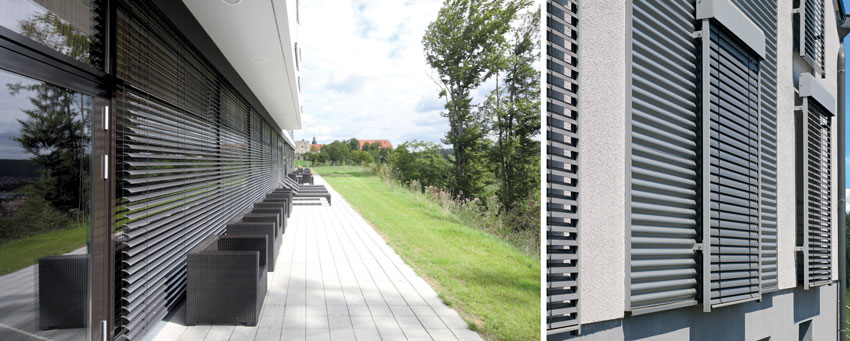
Photos courtesy of Draper, Inc.
Exterior Venetian blinds can provide excellent solar control, allowing in natural light when open and providing maximum heat and light reduction when closed.
The European Solar Shading Organization (ES-SO) guidebook on solar shading claims that workers who are close to an exterior window report 20 to 25 percent fewer major health complaints, while absenteeism falls by 15 percent when access to windows and daylight is provided. A study conducted by the California Energy Commission found that office workers also perform 10 to 25 percent better on mental function and memory tests when provided with the best possible view.
In 2004, Carnegie Mellon University’s Guidelines for High-Performance Buildings reported that maximizing daylight while reducing glare—along with adding responsive lighting controls—improves productivity by a median of 3.75 percent. Given that a productivity increase of 1 percent equals 0.8 percent of operating expenses, this study clearly shows that daylighting and daylighting control impact the bottom line.
Natural light is also pleasing to the eye, and it creates dynamic patterns that enhance the aesthetics of building interiors.
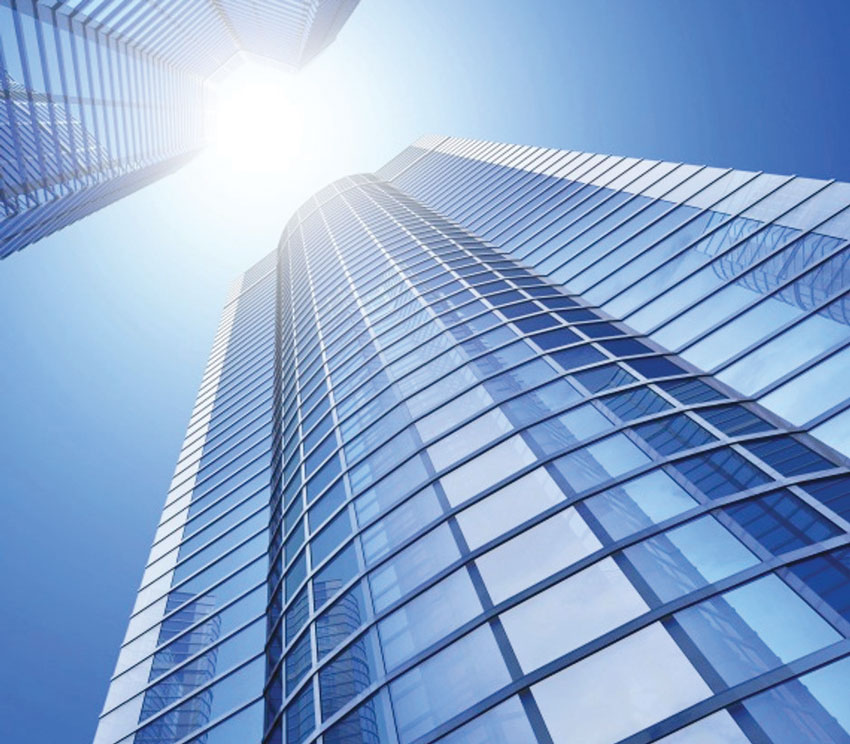
Photo courtesy of Draper, Inc.
Glare from the sun can cause discomfort or disability glare for occupants.
Aside from their benefits, windows in buildings can create glare. Direct sun in the eye can cause disability glare, interfering with the occupant’s ability to see and work. Discomfort glare occurs any time the background brightness exceeds the brightness of the task. Glare can cause eyestrain, headaches, fatigue, and tension, ultimately affecting productivity.
A good rule of thumb for office environments is that the “bright-to-dark” ratio between the screen or work surface and the direct field of vision should not exceed 3:1; in other words, the work area should be no more than three times as bright as the area immediately surrounding it. The ratio between the screen or work surface and the indirect field of vision, or background, can be greater, but should not exceed 10:1.
The use of interior or exterior shading systems can effectively control light through glazing and, together with the artificial lighting scheme, contribute toward achieving good visual comfort and productive working conditions.
In addition to managing glare, it’s also necessary to consider solar heat gain—that is to say, the increase in temperature inside a building space from solar radiation. Solar heat gain is desirable during the heating season because it helps reduce energy demand from the heating system. But in summer, unwanted solar heat gain can increase the cooling energy load and create uncomfortable conditions for occupants. While good design can help prevent direct sunlight from penetrating the building during the summer months, window size and placement alone cannot stop unwanted heat gain.
The goal of any building design should be to maximize the use and benefits of natural daylighting while addressing the problems of solar heat gain and glare. Although building orientation, window-to-wall ratios, window placement, and glazing performance are important considerations, shading systems are usually required to control heat gain and glare through the seasons. To optimize energy use, shading systems should ideally be automatically deployed and adjusted to respond to the exterior conditions, with supplementary artificial lighting only provided when required.
Daylighting can create many benefits as well as challenges. While there isn’t a one-size-fits-all solution, modifications to existing shading systems, specialized solutions, and custom solutions can be implemented successfully to provide health and safety for occupants and well as energy efficiency.
Lighting Solutions and Shading Systems
Shading systems can effectively control daylighting in commercial buildings and also serve as integral design elements. They can be installed on the exterior or interior of buildings, and even between glazing units or within a double facade. There are many types and styles of modern shading systems used to control daylighting in modern commercial architecture.

Photos courtesy of Richard Wilson
Interior shading systems include shades that can be raised or lowered fully or left at intermediate positions depending on the time of day.
Exterior vs. Interior Shading Systems
Exterior shading systems have a big advantage over interior systems: they significantly reduce unwanted solar heat gain by eliminating one of the sources of that gain. Solar radiation is absorbed by shading material, whether installed inside or outside a building. The short-wave solar energy that is absorbed by the shading system is converted into long wave energy (i.e., heat). With an exterior system, this heat is radiated outside the building and never reaches the glazing. However, solar energy that is absorbed by an interior shading system and is then radiated as heat is trapped inside the building. An effective exterior shading system can block 90 percent or more of solar gain. This can contribute to lower HVAC demand, which in turn can contribute to a downsized HVAC system, lower capital costs, and lower operational costs over time.
Interior shading systems consist of shades or blinds that can be operated up or down. Interior blinds incorporate slats, the angle of which can be adjusted to control light, glare, and solar heat gain. Interior shades can be raised or lowered fully or to intermediate positions, depending on the time of day and amount of direct sunlight. Although they are not as effective as exterior systems at keeping solar heat gain out of the building, interior shading systems have other advantages. For instance, there are more material (fabric) options since the shades are not in direct contact with the elements (though they are still susceptible to UV damage). Because they are part of the indoor environment, however, it is important to consider how the material choice impacts indoor air quality. Interior shading systems can be motorized or operated manually.
Examples of exterior solutions include brise soleil systems (i.e., fixed louvers that are installed at the head of the glazing) as well as horizontal louvers and vertical louvers that are installed in front of the glazing. Roller shades and venetian blinds can be used in both interior and exterior applications and retracted into a pocket or a head box when not required. Retractable systems allow for responsive shading—shading that is deployed during certain times of day or under certain weather conditions. In addition, the slat angle of exterior venetian blinds can be adjusted according to the sun’s angle, allowing the maximum amount of ambient light into the building while preventing any direct sun penetration.

Images courtesy of Draper, Inc. and Richard Wilson
Exterior shading systems are more effective at keeping solar heat gain out of the building when compared to interior shading systems. Various types of external shade options are available.
Exterior shading systems are effective throughout the year, which means that they will prevent solar energy from entering the building in the winter as well as the summer months. An advantage of retractable systems is that they can be disabled and left in the retracted position during the winter months, when solar heat gain might be desirable. This is dependent on the building’s heating and cooling cycle. In more southern latitudes, a building might require cooling throughout the year. In more northerly climates, however, winter heat gain is beneficial, and retracting the shading systems to make maximum use of these gains therefore makes sense. If this is the case, however, an interior shading system will also be required to manage daylight and address glare.
Though designed for exterior conditions, these systems should be retracted fully during high-wind events; they also need to be protected from ice and snow. Exterior roller shades that incorporate zip technology are very wind resistant and are an ideal solution for exposed locations and taller buildings. Such systems include steel zippers welded onto the vertical edges of the shade that “lock” the shade into the channels and prevent them from being pulled out by the wind.
Shading systems also can be installed within a double facade. While this type of facade construction is not all that common in North America, it can be very effective in climates that are hot in the summer and cold in the winter. During summer months, warm air is ventilated from the plenum, generally to the exterior, to minimize solar heat gain. During winter months, warm air is trapped inside the facade, acting as a thermal buffer; alternatively, warm air may be brought into the building through interior vents to provide free heating. Venetian blinds work effectively in conjunction with this strategy. Solar energy absorbed by the aluminum slats helps increase the temperature in the plenum, assisting stack-effect ventilation during the summer months and the effectiveness of the thermal buffer during the winter months.

Photo courtesy of Richard Wilson
Double-facade shading systems can be effective in climates that are hot in the summer and cold in the winter.
The cost of this type of facade construction, however, means that it is normally only seen on institutional and owner-occupied buildings. Because the shading systems are installed within the facade, they are protected from the elements, allowing them to be used all year round. They can also be used on tall buildings where significant wind speeds preclude the use of exterior systems.
The construction of a double facade can vary significantly in terms of plenum size, ventilation strategy, and other factors. Normally, venetian blinds are installed within the plenum, although roller shades are sometimes used as an alternative. The shading systems are used throughout the year to provide control of light and glare and to manage solar heat gain. One of the challenges when selecting these systems is that every project is different with varying needs, so developing a shading solution that meets the specific project requirements is important.
Exterior shading systems and ones that are installed within a double facade are an integral part of the building’s environmental control. Because this is the case, they are almost always motorized and will normally be automatically controlled, enabling the systems to respond to sun conditions, being deployed and retracted as appropriate. In the case of venetian blinds, the slats are tilted between a number of preset angles to prevent direct sun penetration while allowing as much ambient daylight as possible into the building.
Modified Products Can Create Solutions
Off-the-shelf systems such as roller shades and venetian blinds may work well for many projects, but for larger projects, more modified and customized versions of off-the-shelf items can provide better solutions.
Interior roller shades are the most commonly used shading system on commercial projects. They can be manually operated or motorized and fully or partially deployed or retracted to address the sun conditions. However, there are challenges that can arise when installing roller shades. Many projects incorporate some irregular-shaped glazing where special shading systems are required. The move toward floor-to-ceiling glazing with narrow mullions can also mean that movements/flex of the glazing system under wind load can have implications on the way that roller shade systems are installed. The Marina Heights project in Tempe, Arizona, is an excellent example of how modified systems can be developed to address building-specific issues and to provide shading for occupants.
The Marina Heights project, which included buildings that are home to State Farm Insurance, needed shading systems to help with daylighting. The large project required more than 8,600 shades to be delivered and installed during the 19-month-long construction process.
Steve Hawes, principal at Progressive Commercial Interiors in Tempe, says the sheer number of 10-foot-high shades required scaffolds and ladders, making the project a major undertaking. “There were five buildings, 47 floors, and multiple floors often requiring simultaneous installation,” he explains.
After being awarded the first part of the project, Hawes got news at a preconstruction meeting with the general contractor that custom brackets were required for the storefront system that was designed to flex under wind load. “Attachments had to be made to horizontal mullions only, and they could not attach to vertical mullions as would normally be the case,” he explains.
Having identified the problem that needed to be addressed, the first step was to obtain a detail drawing of the mullion from the contractor.

Image courtesy of Draper, Inc.
Based on a detailed drawing of the horizontal mullion, engineers produced a 3-D drawing of a custom bracket. The design was slightly modified and approved.
An alternative mounting solution—custom brackets that allowed the shades to be attached to the horizontal mullion—was designed. A 3-D drawing of the design was provided to the contractor, who provided suggestions for improvement.
The final step in the design process was producing 3-D printed sample brackets to test with a mockup section of mullion. The custom design was approved, and the brackets were manufactured. The installation began in May of 2015 and was completed in December 2016.
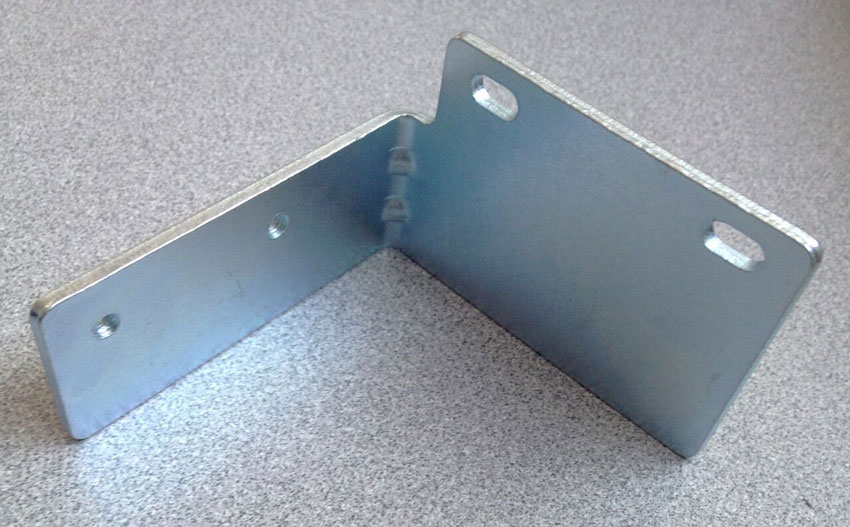
Photo courtesy of Draper, Inc.
The final bracket is designed to avoid attachment to the moveable storefront.
By understanding the issues, working with the design team, the facade contractor, and the installer, it was possible to make relatively minor adjustments to the shade bracket design to address a significant problem and to create an effective solution to allow the easy installation of the shades on the project.
While some roller shade projects might have issues to address regarding connections to the building structure, the selection of an appropriate fabric is important on all projects to ensure that the correct balance is achieved between appearance, daylight control, glare control, and views to the exterior. Two features that significantly impact the performance of a shading system are openness and color of shading fabric. In broad terms, openness refers to the area of the fabric through which light can pass, expressed as a percentage. Common openness factors are 1 percent, 3 percent, 5 percent, and 10 percent. The higher the percentage, the more light can pass through the fabric. In addition to light transmittance, a more open fabric also allows more solar energy to pass through it and be absorbed by the fabric or the building, carpets, furniture, etc. This solar energy, once absorbed, is converted into heat. Getting the correct balance between light and heat gain is therefore important and will vary across a building. Ranges of fabric that have a variety of openness factors therefore allow different versions of the fabric to be selected, as appropriate, while maintaining a consistent appearance throughout the building.
Fabric color also considerably impacts a shade’s performance. Lighter colors are better at preventing solar heat gain, as they reflect more of the solar energy than darker colors; they also allow more diffuse light transmittance. Conversely, the reflective characteristic of light colors makes viewing through the shade more difficult. Darker colors are generally better at controlling glare and light, and they are a better choice for preserving views, as they allow occupants to see through to the outside. The downside is that darker fabrics absorb more of the solar energy, which is then radiated into the room as heat. There is continuous development of fabrics, however, to try and address these issues with the intention of maintaining views to the exterior while achieving a good solar performance. Twill woven fabrics that are a light color on one side and dark on the other, metallized fabrics that increase reflectivity on the side of the fabric that faces the glazing, and chemical treatments that reduce the solar absorption of dark fabrics are all available options that can be considered during the fabric selection process.
The most common woven fabrics for shading systems are made from polyester or fiberglass yarns. Most fabrics also utilize PVC coatings to provide color and stability. PVC-free fabrics are becoming more prevalent, however, although they may not be appropriate for all shading requirements. With long drop shades, the stability of PVC-free fabrics can be an issue; this is also the case with fabric tension systems where the inherent stretch in PVC-free fabrics is an issue.
Because of all the fabric options available, finding the right solution can be a complex exercise. On larger projects, larger fabric samples can be supplied to allow the design team and the client to get a better understanding of fabric performance.
The University of Chicago Laboratory Schools case study shows how a modification to motorized shades and careful fabric selection were able to provide a solution to glare and heat gain in a building that contains large, uniquely shaped windows throughout.
The University of Chicago Laboratory Schools was building a brand-new arts facility, the Gordon Parks Arts Hall, funded in part by a donation from the George Lucas Family Foundation. It was a high-profile project that included effective daylighting as part of the design brief.
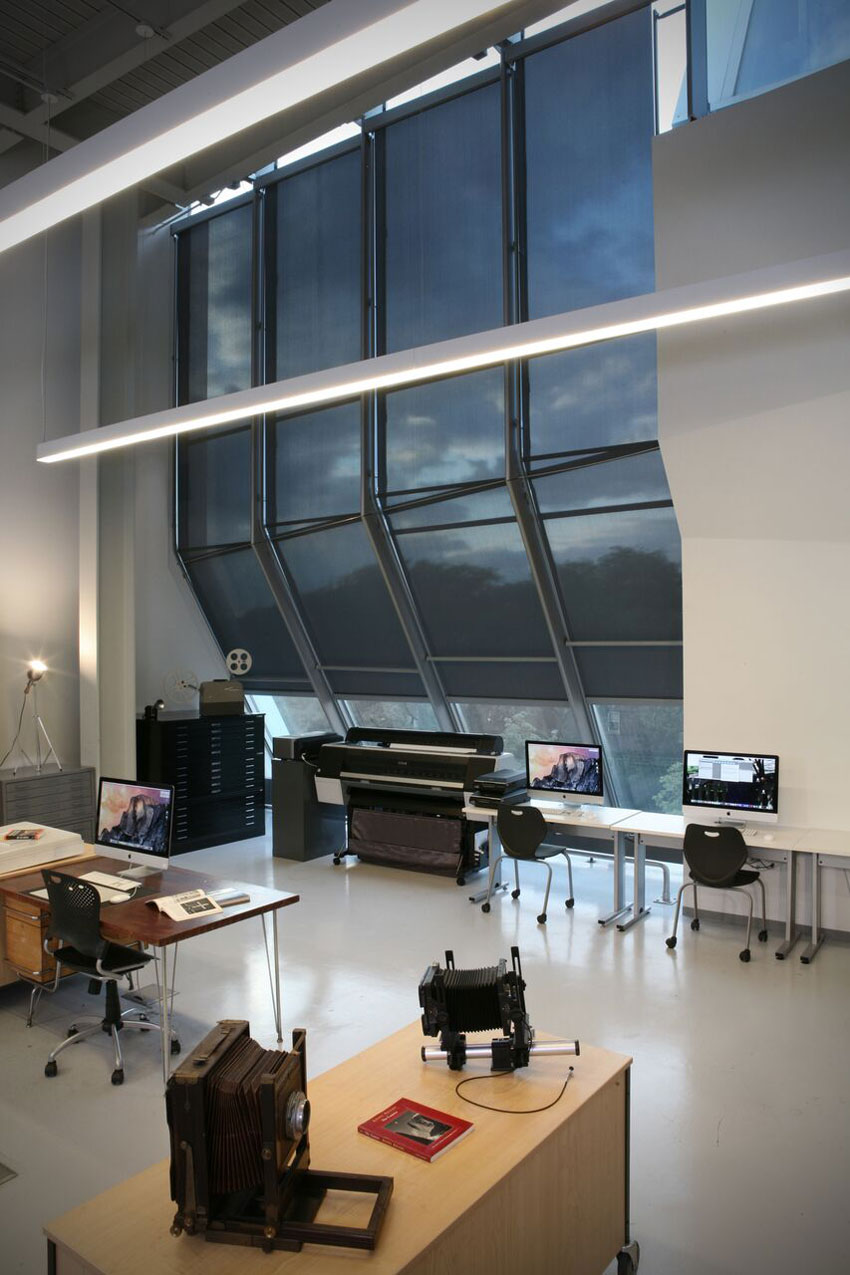
Photo courtesy of Draper, Inc.
A custom motorized system on tracks addressed the specific building conditions at University of Chicago Laboratory Schools.
The architects had developed a beautiful facade design with unique angles and breaks in the glass. With this design, however, they had a problem finding any solar shading that would work with the facade geometry.
Bryan B. Biggers III, president of Beverly Venetian Blind Company, says it was a complex project. He and his team talked to the architect in charge of the project to share some ideas on how to develop a solution.
After an exchange of ideas and on-site meetings, it was agreed that a custom motorized shade system should be developed to address the specific building conditions. The system would incorporate side guide tracks with redirectional rollers to allow the shades to follow the changes in slope. The shades would be operated via wall switch and feature a 3 percent openness factor.
One of the biggest challenges for the teams was the number of different brackets required to address the facade layout. With the changing break line in the curtain wall glass per shard, each shade was slightly different. There were different length tracks—both left and right side for each shade—different length brackets, and different quantities of brackets per system. Another issue was bending the side guide tracks. Three-dimensional engineering rapid prototyping machines and a process using printed plastic inserts allowed the solution provider to use a gym equipment tube-bending machine to bend the U-channel profile of the side guide tracks.
The project continued to be challenging as installation got underway. The shading systems were designed from the approved facade shop drawings. Biggers’s crew had to make some on-site adjustments and fabrication changes, however, because as they moved across the glazing, it soon became apparent that there were some changes from the angles shown in the drawings.
Specialized Solutions
While modified solutions are sufficient for some applications, at times, a more comprehensive solution is required in the form of a specialized outcome. Specialized solutions use existing products that are available in the European market but not generally known in the United States, but, on occasion, they can also require additional creativity and expertise to ensure the best results are achieved. These specialized solutions can be appropriate for both interior and exterior shading requirements.
A noteworthy example of this is the installation of a specialized solution at Duke University’s Richard H Broadhead Center for Campus Life on the West Campus.
The Richard H. Broadhead Center for Campus Life on the West Campus of Duke University was designed by Grimshaw’s New York office. The building is a modern addition to the Gothic-style Duke Campus and incorporates a substantial amount of glazing. In the base contract, the only glazing that was shaded was the upper level roof glazing as shown in the drawing below.
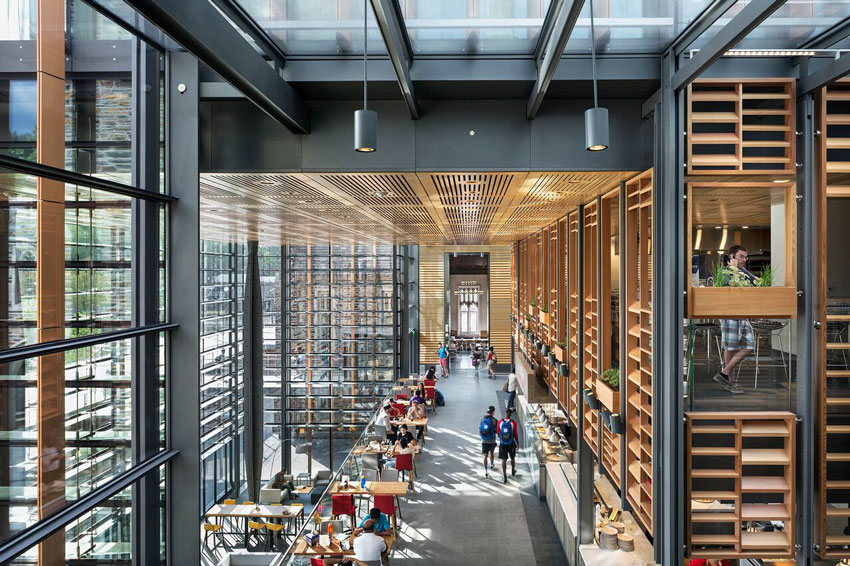
Photos courtesy of Jill Fredrickson/Front Inc.
Specialized shading systems were installed at the Richard H. Broadhead Center for Campus Life on the West Campus of Duke University.
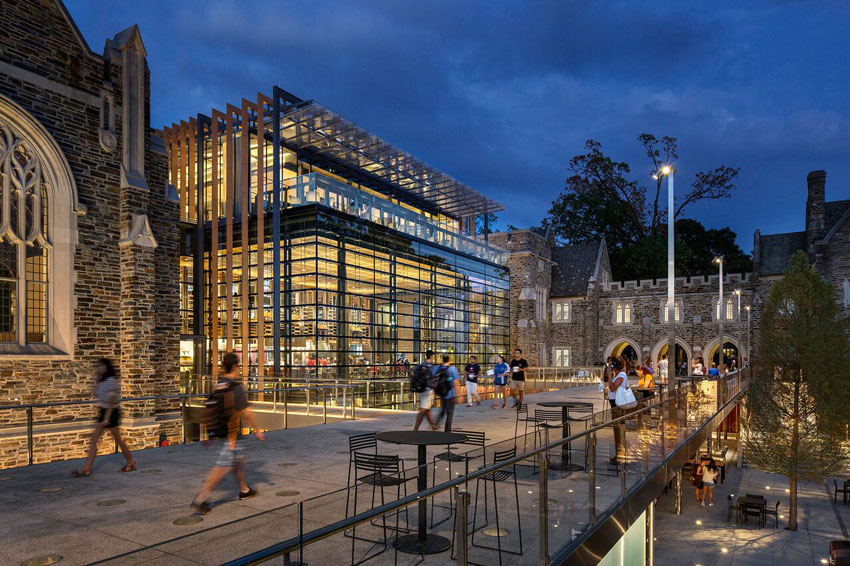
The Richard H. Broadhead Center for Campus Life on the West Campus of Duke University features modern shading systems that stand out among the surrounding Gothic-style buildings on campus.
The main issue to be addressed was the fact that the shading systems needed to draw to the vertical facade glazing, which could not be subject to any tension loads. This meant that a cable-guided tension system with return pulleys that connected to the building structure could not be used.
Two main options were considered: a retractable system comprising a series of fabric panels that are mounted onto spring roller tubes (retractable fabric panels) or a more standard-fabric tension system with side guides incorporating return pulleys. Of the options, Grimshaw preferred the appearance of retractable fabric panels and thought it worked well with the architecture of the building, especially if the spring roller tubes could be aligned with the skylight structure above.
The broad construction of the retractable fabric panel system is as shown in the schematic below. A drive tube, incorporating a tubular motor, is mounted onto the two side tracks of the system. Running between the side guides is a series of spring roller tubes which are connected to wheeled trolleys that run in the side tracks. Two fabric panels are mounted onto each spring roller tube allowing the panels to be connected to the adjacent spring roller tubes, creating a continuous system when it is deployed. The drive tube has cord spools on each side; the cords run inside the side guide tracks, around pulley wheels and connect back to a hem bar that is attached to the first fabric panels. When the motor is operated, the cords pull out the hem bar, which in turn starts deploying the fabric panels. When the motor is reversed, the spring roller tubes wind the fabric panels onto them, retracting the system.


Images courtesy of Draper, Inc.
Shown is a schematic of the retractable fabric panel system used at the Richard H. Broadhead Center for Campus Life on the West Campus of Duke University.
A potential issue with the retractable fabric panels is that the size of the retracted package is quite substantial, as it incorporates both the drive mechanism and the retracted spring roller tubes. However, the building design allowed a pocket into which the system could be installed. The limited draw of the systems (approximately 11 feet) meant that the retracted package was not too large and that an overall pocket dimension of 13 inches deep by 12 inches tall was sufficient. This amount of space was available.
The other issue to address was that although the system pulled out horizontally, the drive mechanism needed to be set to an angle of 4 degrees from horizontal because of the slope of the roof glazing. This was not an issue with retractable fabric panels.
The key design requirement was the coordination with the ceiling and support structure to ensure that the size of the pocket was sufficient to hide the system when fully retracted and also allow the installation of the system and access for any subsequent maintenance. Once this was resolved, it was possible to manufacture and install an elegant and effective shading system.
There are many examples of projects that required specialized solutions to complex shading problems. Another example is the Gateway Center Hotel at Oberlin College, which utilized exterior venetian blinds to help with proper daylighting and shading.
The Gateway Center at Oberlin College is a mixed use building incorporating guest rooms, event and conference spaces, a welcome center, farm-to-table restaurant, and the College’s administrative offices. The intention of the architects, Solomon Cordwell Buenz (SCB), and the college was to create a highly sustainable building that would become only the fifth new hotel in the United States to achieve LEED Platinum classification. Additionally, the aim was to achieve net-zero energy consumption and net-zero carbon production.
To achieve these aims, the design incorporated a range of innovative features, including radiant heating and cooling, geothermal power, photovoltaics, rainwater collection, a thermal envelope with rainscreen technology, natural ventilation, and automated exterior venetian blinds. Measured by energy use intensity, the building is expected to be among the top ranking commercial structures in the United States, using 55 percent less energy than comparable buildings.
Because of the benefits of exterior shading, the architects decided to include long-drop venetian blinds on the west-facing elevation of the event space as well as exterior venetian blinds for the hotel bedrooms. As part of the discussions about the project, a shading analysis was conducted to look at the performance of the shading for the hotel bedrooms. Eventually, a decision was made to move to interior shading in these locations, but exterior venetian blinds were incorporated into the design of the event space. The blinds allow views to the outside while providing effective solar control, reducing interior heat gain and contributing to the outstanding energy performance of the building.

Photo courtesy of Draper, Inc.
Exterior venetian blinds were installed on double-height west-facing glazing to provide occupants of the Hotel at Oberlin with outside views while also providing effective solar control.
Custom-Designed Solutions
While there are many ways to incorporate shading into a space, including off-the-shelf shading systems as well as modified products and specialized solutions, these may not meet architectural requirements in every situation. In such cases, a custom-designed solution that is specifically developed for the project might be the best approach. Custom solutions are generally developed from scratch to meet the specific requirements of a project.
The main aim is to develop a system that effectively addresses the control of natural daylight and solar gain. It is important, however, that the system also meets the design intent in terms of aesthetics and integration with other building components while meeting the budget constraints of the project. Budgetary constraints largely preclude the possibility of developing a custom system for a small project. It becomes feasible, however, as the scale of the project increases.
The Canadian Parliament West Block Rehabilitation Project is an excellent example of how a custom operable louver system provides a daylighting solution.
The Canadian Parliament Building complex in Ottawa is currently being refurbished. The project was started in 2002 and will continue until at least 2023. From around 2019, the main Centre Block of the complex, which houses the legislative chamber of the Canadian parliament, will be closed for a five-year-long renovation. Prior to this happening, the West Block was renovated and the courtyard converted into a legislative chamber that will be used while the Centre Block is out of commission.
The conversion of the West Block courtyard included the installation of a multilayer roof structure comprising a supporting steel structure, outer glazing, a louver system to provide light control, an access catwalk, and an inner laylight. On completion of the work, the temporary House of Commons will have a stunning roof structure while maintaining many of the original courtyard features.
The proceedings of the House of Commons will be televised so the control of light through the roof structure is critical. To achieve this, an adjustable louver system was required to allow ambient light into the chamber while preventing direct sun penetration.
The operating requirements for the louvers were established by the climate engineering company Transsolar. Among other things, the control specification set out the need for the louvers to be able to rotate through 180 degrees to allow the system to track sun movement throughout the day from sunrise in the east to sunset in the west.
Given the complex geometry of the roof and the need for 180-degree louver rotation, it wasn’t possible to use a typical solution. As a result, the solution provider worked closely with the facade engineers, Front, as well as Transsolar and the skylight contractor, seele, to develop a custom system that would meet the highly specific project requirements.
All the components of the system were designed from scratch to address the specific project conditions. A key element of the design was the development of a drive mechanism to allow 180-degree rotation.
The final design included a drive bar with sections of rack mounted at each louver location. These racks engaged toothed wheels mounted on the louver shafts. Consequently, as the actuator drives forward and back, the louvers are rotated. Adjusting the actuator stroke allows the amount of louver rotation to be increased or decreased as required.
Two mockup systems were then manufactured and installed at seele’s facility in Germany. The mockup systems were reviewed by the design team and modifications to the design were made to address any issues.
To minimize noise generated by the system, alternative linear actuators were considered. Noise measurements were undertaken on the mockup in Germany, which resulted in replacing the original actuator with one that could achieve significantly quieter operation.
The mockup also allowed maintenance issues to be considered, including the feasibility of replacing louvers, replacing an actuator, and in the event of an emergency, closing a bank of louvers if an actuator failed.

Photo courtesy of Draper, Inc.
A louver system is being installed in the Canadian Parliament building to allow ambient light into the chamber while preventing direct sun penetration.
Another example is the Plaza Tower project in Greenwood Village, Colorado.
The 22-story Plaza Tower One was built in 1987. The structure contains large arched windows at the top level on both sides of the building. The original shading systems were effective and met the architectural requirements. Over time, however, some problems arose and a lack of spare/replacement parts meant that the systems could no longer be operated. To solve this problem, the shading was replaced with a series of bottom-up shades with cables. Compared with the original shading installation, the new system was not very elegant and was unliked by the building tenant, who called for its replacement back to something along the lines of the original system. Unfortunately, the old system was no longer available.
In August 2017, Premier Commercial Interiors began working with a shading company to develop a solution. Several potential solutions based on regular and tension shades were too similar to the solution the tenant had rejected. One proposal included a series of triangular shades that drew to the bottom center of the arched glazing. This was an interesting solution but resulted in drive cables being permanently in front of the glazing, which was not acceptable to the tenant.
Eventually, a skylight shading system that incorporated a motorized track and a series of triangular fabric panels was proposed. While the system broadly met the Plaza Tower project requirements, there were a number of significant issues to address. In particular, the proposed system was designed to deal with horizontal rather than vertical glazing, and it had a maximum radius of approximately 10 feet. For the Plaza Tower project, the required radius was almost double this at approximately 18 feet 6 inches.
In October 2017, following discussions about the project and the requirements that had to be met, a full-size mockup of the system was produced using available components to demonstrate the feasibility of the proposed solution. The system was proposed to the building owner, who accepted the solution and placed an order in March 2018. Engineering work was commenced immediately, and a number of changes were made to the original system, including the introduction of a second motor for each track to cope with the required size of the systems and the development of a mechanism to provide tension in the large fabric panels. The design of the custom system was finalized in June 2018, and installation began in September 2018.
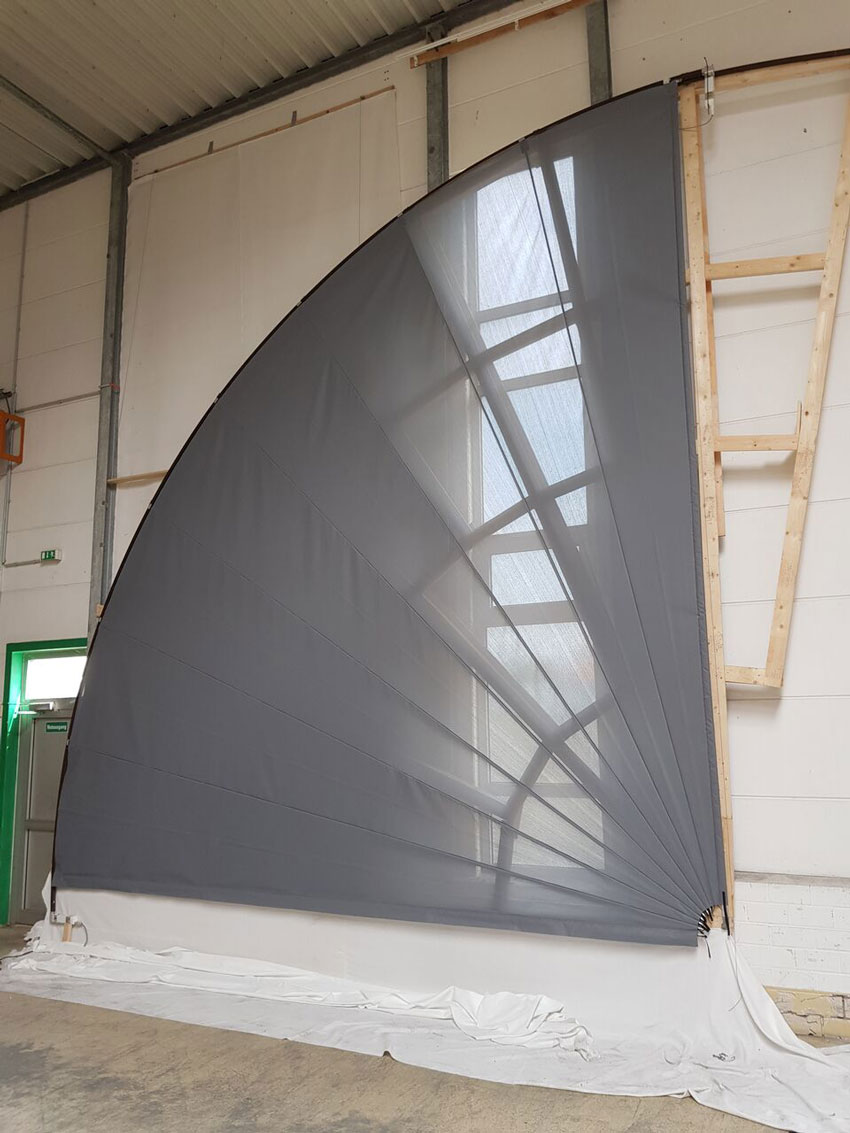
Photo courtesy of Draper, Inc.
The customized shading solution for Plaza Tower was so complex and unique that it required consultations from multiple professionals and experts. The final design was purchased and implemented in 2018.
These examples of custom-designed solutions illustrate the complexities involved when providing specifications and design plans for shading systems. To provide solutions for the Canadian Parliament and the Plaza Tower, multiple experts were consulted and worked together to provide a plan that would satisfy occupants and also meet their working needs.
Energy Efficiency
According to the National Institute of Building Sciences, proper daylighting requires not only providing enough daylight to an occupied space but also balancing glare, heat gain and loss, and variations in light throughout the day. With all the shading options available, there are many ways to reduce glare and limit heat gain and loss, thus positively affecting occupant health and safety by providing sunlight while also the harmful effects of too much sun exposure. In addition to providing health, safety, and welfare for occupants, shading and daylighting solutions also improve a building’s energy efficiency by limiting heat gain and loss, thus reducing the use of HVAC systems.
Though a shading system may come with a substantial initial cost, this must be balanced against the reduced capital costs associated with a possibly downsized HVAC system and the reduced operational costs made possible by lowered energy demand. The benefits to building occupants, including improved health and productivity, and the aesthetic advantages, including reduced glare, enhanced views to the outside, and reduced UV damage to interior finishes and furnishings, also should be considered. It should be noted that a shading system can also contribute to a project’s sustainability goals, which may include a healthy indoor environment, energy efficiency, and longevity of building components.
By reducing the reliance on artificial lighting, natural daylighting can potentially reduce building energy use by up to one third. This is significant. Electric lighting accounts for 35 to 50 percent of the total electrical energy consumption in commercial buildings. Strategic placement of windows and skylights in the building envelope ensures most areas receive ample, diffuse light. To maximize energy savings, daylighting must be integrated with an effective shading system coupled with lighting controls, such as dimmers and occupancy sensors, so that artificial lighting is used only when needed.
Conclusion
When considering shading solutions for a building, it is important to understand that there are many options available, but no single product can provide a comprehensive solution. Ideally, a shading expert will provide consultation during the design process. Through the use of modified products, specialized solutions, and custom solutions, it is possible to provide health and safety to occupants through proper sun exposure while also limiting eye strain caused by glare. These comprehensive solutions allow for a positive environmental impact through energy efficiency and reduce energy costs.
Resources
Ander, Gregg D. “Daylighting.” Whole Building Design Guide. National Institute of Building Sciences. 15 Sept. 2016. Web. 26 Sept. 2018.
Offering Solar Control Solutions for Every Application. Draper. Web. 26 Sept. 2018.
Solar Shading Benefits. European Solar Shading Organization. Web. 26 Sept. 2018.
Windows and Offices: A Study of Office Worker Performance and the Indoor Environment. California Energy Commission. October 2003. Web. 26 Sept. 2018.
Jessica Jarrard is an independent writer and editor focusing on health, science, and technology. She contributes to continuing education courses and publications through Confluence Communications. www.confluencec.com

















